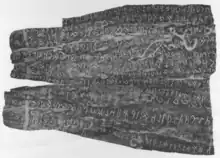The Elegest inscription is a Yenisei Kyrgyz inscription. It was found by J. R. Aspelin in 1888 on the left bank of the river Elegest, Tuva.[1]
Discovery and translation

Elegest inscription
Region
Complete text
|
Old Turkic original text:
|
English translation:
|
Old Turkic original text:
|
English translation:
|
Notes
- ↑ The letters <kẄrtlKN> are interpreted by Tekin (1995: 20), Kormušin (1997: 236-237, 2008: 101) and Sertkaya (2017) as körtlä qan. Since the final vowel of körtlä is not written, it is either a mistake in the inscription or the two words were handled by the author as one unit, i.e. a compound. See the inscription Elegest II with plene writing of the vowel in <kẄrtlA> körtlä. Cf. the word körtlä 'beautiful' appearing in other Old Turkic sources. The interpretations kürt el kan by Orkun (1940: 180) and kört äl kan by Malov (1952: 26) are unlikely.
- ↑ The runiform letters <rlrmdẅkmYwK> are interpreted by Sertkaya (1995: 739) as er ölürmedüküm yok '(düşman askeri) öldürdüm' and (2010: 211-212) är ölürmädükim 'er (savaşçı) öldürmediğim', whereas Kormušin (2008: 101) reads ärlärmädükim joq 'ja (lično) ne poražal voinov (vraga)'.
- ↑ The phrase säkiz adaqlïγ barïm most likely describes properties or belongings of the pastoral nomads pulled by four legged draught animals on four wheeled carts, hence the number eight.
References
Further reading
- Talat Tekin, 1964: "On a Misinterpreted Word in the Old Turkic Inscriptions."
This article is issued from Wikipedia. The text is licensed under Creative Commons - Attribution - Sharealike. Additional terms may apply for the media files.